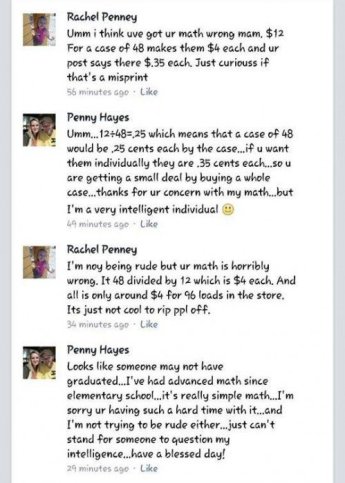Recently, a woman apparently tried to sell some detergent at a discount on an online forum and the resulting chaos that ensued from people trying to do elementary math was nothing short of mind-boggling. Literally.
Here’s the issue. The woman “offered the bottles of detergent for $0.35 each, or one thrifty individual could snap up the lot of 48 for just $12.”
People immediately objected.
Whoo, boy. How in the world?…never mind. Common Core math. I get it.
So what is the actual explanation? For those on the forum (including the moderator, eventually), who were befuddled by this problem?
You have 48 items. You want to sell all of the items for $12. The other option is to sell each item individually for $0.35. Now, how much would the lot (48) cost if they were $0.35 each? You can multiply $0.35 by 48 and get the answer. Because you have 48 things, and they each cost $0.35, this is how to find out how much the lot costs. $0.35 x 48 = $16.80. Okay, so that’s how much the whole thing costs if you were to pay $0.35 each. $16.80.
Now, the first option (the deal, or “scam”, if you’re the moderator) was to sell all 48 of the items for $12. $12 is smaller than $16.80 by $4.80. That means you save $4.80 by buying them in bulk.
Another way to do this problem is to work in the other direction, from option 1, and then compare with option 2. You have 48 items. You want to sell them for $12. How much are each of the items? Well, $12 is for all 48. You want to know how much just 1 item is. The people in the forum were mistakenly dividing 48 by 12, and getting $4 each (what a ripoff!). This is backwards. This would be what you would do if you wanted to sell 12 items for $48. Instead, you have to divide 12 by 48. And what do you get? $0.25. That is cheaper than $0.35 by $0.10. You save $0.10 x 48 items = $4.80. That’s the same as before, so we know we’re right.
The reason why everyone is so confused by this problem is because they apparently were never taught elementary school level algebra, which is a really useful system for organizing mathematical thought (and probably not taught in Common Core).
You have 48 items, and you want to sell the lot of them for $12. How much does each item cost? Well, you know that each item’s cost ($x) is going to be multiplied by the number of items to get the total cost. So it should look like this:
($x) * 48 = 12
In algebra, the name of the game is to isolate x. Once you’ve isolated it on one side of the = sign, you can get your answer as to what it is. How do you isolate x in this problem? By doing the opposite operation that is shown. The * signifies multiplication, and the opposite of multiplication is division, so you divide both sides by 48 (you always have to do the same thing to both sides of the = sign or it isn’t = anymore).
[($x) * 48] / 48 = 12 / 48
What does this mean? It means that x times 48 divided by 48 is equal to 12 divided by 48. Whenever something is multiplied and divided by the same thing, that thing goes away, because it ends up just being 1. Why? Because 48 over 48 is 1. 48 divided by 48 = 1. 1 times anything is just that anything, by itself.
$x = 12/48
12/48 is equal to 1/4, which is equal to 0.25. So $x = $0.25 (which is less than $0.35).
Algebra can help you organize your thoughts, and prevent confusion about problems like this. Everyone makes mistakes sometimes. When you get confused, go find something to write on and work the problem out in algebra format. It will help you see it more clearly and realize what is actually happening.

As an elementary school math teacher I taught that the purpose/process of division is to divide by the number that you want to become a one, such as the “per bottle” discussion. Since you begin with 48 bottles, you divide by 48 to determine the cost of one bottle. Therefore 12 divided by 48 yields the correct answer of $0.25 each. The math is not as difficult as is the reasoning needed to properly set up the problem. The question to ask yourself is what is the variable that you want to reduce to “one”?
LikeLike
Thanks for this insight, that’s precisely the kind of reasoning that was needed to solve the problem!
LikeLike